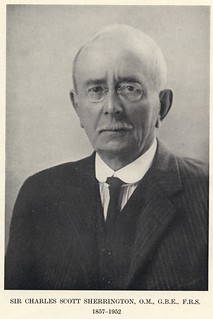- External URL
- Creation
-
Creator (Definite): Sir Charles Scott SherringtonDate: 1892
- Current Holder(s)
-
- No links match your filters. Clear Filters
-
Cites
 Plate XXI, Journal of Physiology 13 (6) (1892). Figs. 7-15 from C.S. Sherrington, 'Notes on the Arrangement of some Motor Fibres in the Lumbo-Sacral Plexus'.
Plate XXI, Journal of Physiology 13 (6) (1892). Figs. 7-15 from C.S. Sherrington, 'Notes on the Arrangement of some Motor Fibres in the Lumbo-Sacral Plexus'.
Description:Explanation of Plate XXI (figs. 7-15):
'Figure 7. Connection between external saphenous nerve and external plantar in Macacus rhesus.
Figures 8 and 9. Schemata illustrating the distribution of the fibres of the motor roots of the lumbo-sacral nerves of Rhesus; fig. 8, in the "postfixed" class of the muscle-supply; fig. 9, in the "prefixed" class of muscle-supply.
Figure 10. Spinal cord; admixture of large and small ganglion cells in the lateral horn at the first thoracic segment. (From photo-micrograph by Mr E. C. Bousfield).
Figure 11. Spinal cord shewing same admixture; lower magnification.
Figure 12. Bundles of the anterior root of the 9th thoracic nerve four months after section of the cord between the 8th and 9th thoracic nerveroots. (From a microphotograph taken by Mr E. C. Bousfield.)
Figure 13 Effects of division of the anterior roots of the right-hand 2nd and 3rd thoracic nerves. Sketched from nature by Mr M. H. Lapidge. "On the side of the section the pupil is small, the hair is flat, the palpebral opening small, the conjunctiva watery, the lower lid somewhat baggy, the cheek somewhat puckered, the pinna slightly flushed and projecting from the side of the head." - Extract from protocol.
Figures 14 and 15. Simple contractions of the gastrocnemius - (frog) registered from separate excitations of the spinal roots viii and ix. (p. 709).' (770-771)
Figs. 10-11 in text:
'The lateral horn of the 3rd thoracic segment characterised by its spindle-shaped nerve-cells averaging 33 µ, in length and by the relative paucity of its nerve-fibres is found in the two Rhesus cords but little altered as far up as the middle point of the superficial origin of the 2nd thoracic root. In the sections taken from the 2nd millimeter above that point it becomes altered, the alteration consists in the appearance of some large cells in the lateral horn at its base. (Figs. 10 and 11, Pl. XXI.) These large cells measure far more in length (90 µ) and breadth (40 µ) than do any cells in the horn of the 3rd and 4th thoracic segments of the cord.' (697)
Fig. 12 in text:
'Wishing to test somewhat more closely this question respecting the relative positions of the superficial and deep origin of the anterior roots I divided the cord of Rhesus completely across close above the 9th thoracic nerve-root, and then examined the condition of the fibres in its rootlets four months later. I found them to contain, even the most anterior (highest) of them a large number of sound nerve fibres (Fig. 12, Pl. XXI.). The sound nerve fibres were both of large and small diameter, the smaller being evidently those described by Reissner [note: 'Archiv f. Physiol. 1862, of. also Beck, Phil. Trans. 1846, p. 213.'] and
Gaskell [note: 'This Journal, Vol. VII. loc. cit.'] and ascribed by the latter to efferents going to the sympathetic system.' (707)Fig. 14 in text:
'When instituted on an excised muscle the degree to which fatigue produced through the "fatiguing" root influences the response obtainable from the test root is more marked, the influence becomes apparent earlier and persists longer. Fig. 14, Pl. XXI. gives an example.' (711)








